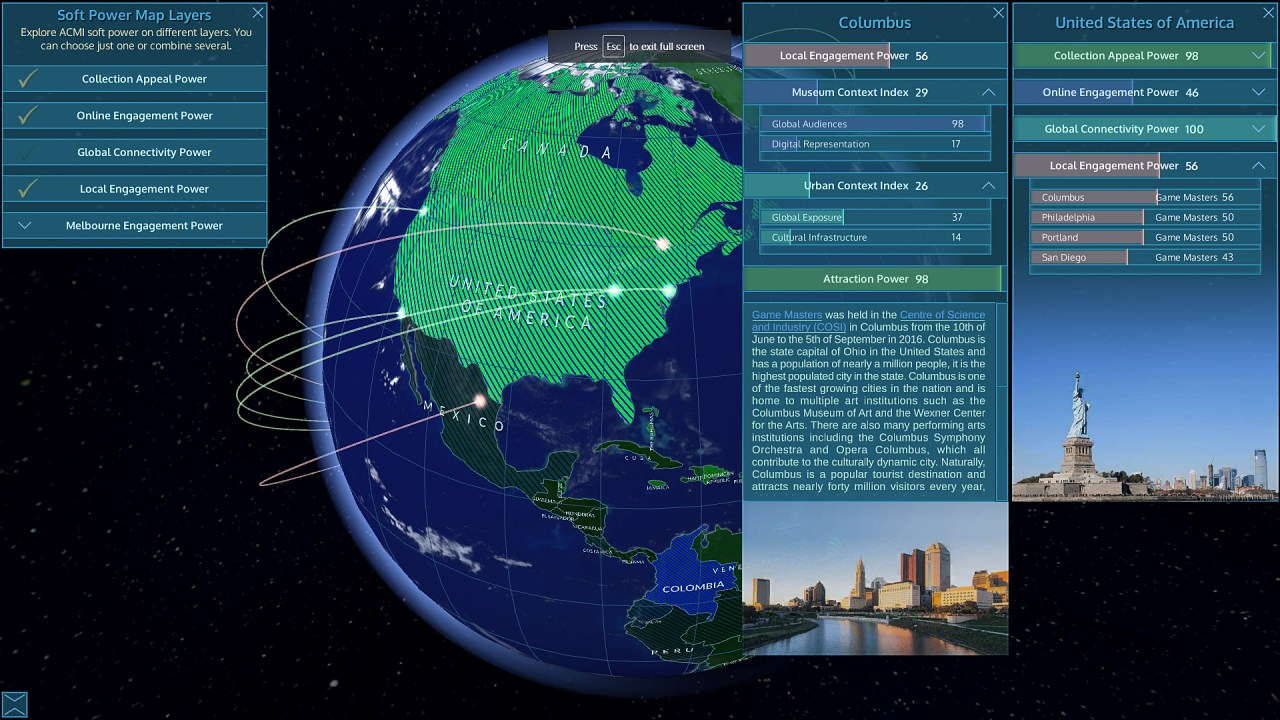
One of the best things about working for the Alliance is the chance to meet interesting people who drop by our offices to chat about their work. One recent visitor was Dr. Natalia Grincheva, a research fellow in the Research Unit of Public Cultures at the University of Melbourne. Natalia has been working with staff of the Australian Center for the Moving Image to develop a tool that digitally maps the geographic reach of ACMI’s influence. In today’s guest post, Natalia shares this work with you, as well.
–Elizabeth Merritt, VP Strategic Foresight and Founding Director, Center for the Future of Museums, American Alliance of Museums
The power of museums to attract tourism and facilitate urban regeneration is well-recognised, with the Bilbao effect as the most symbolic example. However, nobody has attempted yet to understand how the “attraction” power of museums works. Challenged by this question, my recently completed experimental research project, Deep Mapping: Creating a Dynamic Web Application Museum Soft Power Map, offered a solution. This collaborative practice-based creative research piloted a demo version of the first in the world digital mapping system. This system can not only measure attraction power of museums, but also visualise it on the global map. The project employs Joseph Nye’s concept of soft power, the ability to influence the behaviour of others through persuasion and attraction.
In Museums, Cities and Soft Power (AAM Press, 2015), Gail Lord and Ngaire Blankenberg defined museums as “networked civil society institutions with soft power” that can “amplify civic discourse, accelerate cultural change, and contribute to cultural intelligence among the great diversity of city dwellers, visitors, policy makers and leaders.” Written by museum planners rather than academics this book symbolised a new turn in museum thinking, repositioning these institutions as key actors of creative economies, taking leading roles in place branding, urban regeneration and the development of tourism. Recently, the concept of soft power has been increasingly employed by museums to explore their growing visibility, reach and impacts beyond their home sites. However, there has been a lack of understanding how one could assess this power and how this power would vary in different cultural communities and geographic locations.
Developed in collaboration with the Australian Centre for the Moving Image (ACMI), the project designed a pilot web application, ACMI Soft Power Map, a focused, single-museum online tool to geo-visualize and assess the museum’s “attraction power” in Melbourne and abroad. The digital platform exposes and explores correlations in geographical layers of museum data on several levels, including collections, online and onsite audiences, international activities and constituencies. The deep mapping system contains five key layers that allow users to evaluate ACMI power on the soft power conversion scale from mere resources, to strategic outputs and, finally, to a target response. (See embedded video at the end of this post for a tour of the application.)
In terms of cultural resources, the Collection Appeal Power Layer maps the cultural and linguistic diversity of ACMI’s collection, which includes around 200 thousand films, 70 percent of which were produced outside Australia. Moreover, the collection contains movies in 49 different languages that makes this content accessible to people living in over two hundred countries around the world. These collection characteristics are correlated with multiple variables pointing to the social demographic profile, physical or digital mobility of population of each country. The layer helps to identify cultural resources and evaluate their potential appeal on the global map to develop more focused strategies to engage international audiences.
The digital mapping system measures audience engagement power across three layers, including 1) global online followers, 2) local Melbourne audience and 3) international visitors to ACMI touring exhibitions. In the last decade, ACMI international shows travelled to 16 cities across the Asia-Pacific region, Europe, and the Americas. On each of these layers the digital mapping system exposes the geographic origin of ACMI audiences. More importantly, it reveals who these people are. For example, the Melbourne Engagement Power Layer maps how ACMI visitors are distributed across over two hundred post code areas in the city. It also provides key data on each neighbourhood in terms of social demographic profile, cultural, religious and linguistic diversity, family, household, professional affiliation, and income information. Such mapping helps to reveal geographic zones of unrealized opportunities while identifying zones of maximal audience engagement.
Finally, the Global Connectivity Power Layer measures diversity, geographic spread, durability, and strength of institutional connections established between ACMI and around 180 organizations in 80 cities across the globe. It maps the global organisational ecosystem of ACMI, revealing its strong ties with Europe and North America and emerging relationships with cultural institutions in the Asia-Pacific region. This layer visualizes the institutional interdependencies and complex interconnections that exist between the museum and its partners across the globe.
I invite you to learn more about the digital mapping system and its implications for museum operations by joining me on December 10 for a free global webinar that will bring together museum professionals and academics to discuss the project. This interactive round-table will encourage experimentation, networking and a collaborative exploration of what museum soft power is and how it can be measured and analysed. Guest speakers will include Gail Lord, President and Co-Founder of Lord Cultural Resources, Seb Chan, ACMI Chief Experience Officer, Chris Harris, ACMI Head of Exhibition and Touring, Natasha Mian, ACMI Coordinator for the Development team and Eliza Coyle, Community Programs Officer at Yarra City Council Libraries.
Dr. Natalia Grincheva is a Research Fellow in the Research Unit of Public Cultures at the University of Melbourne. She is a dedicated scholar with internationally recognized expertise in contemporary museology and cultural diplomacy. Her publication profile includes over 30 research articles, book chapters and reports published in prominent academic outlets. She is the holder of numerous academic awards and fellowships, including Fulbright (2007-2009), Quebec Fund (2011-2013), Australian Endeavour (2012-2013), SOROS (2013-2014) and others. You can follow her on Twitter: @Grincheva and LinkedIn: https://www.linkedin.com/in/grincheva/








